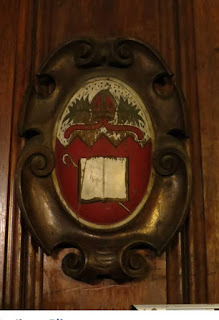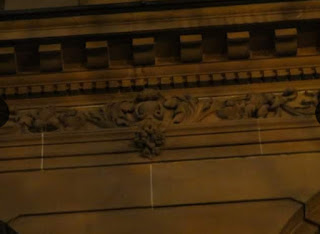April 4
On this day in 1820 the foundation stone was laid for the building that would eventually became the Queen Victoria Building (QVB) on George, Market, York and Druitt Streets in Sydney. The site has a long history as a fresh produce market and was also at one time the Central Police Court. The Romanesque architecture of the QVB as we now know it was designed by George McRae and completed in 1898.
Photo ( Old Police Court (now site of the Queen Victoria Building), George Street, Sydney (NSW)
The Queen Victoria Building ..
The Queen Victoria Building Designed by City Architect George McRae, WasSydney's Central Markets, Was Constructed between 1893 & 1898,.
At the Height Of the Reign Of Queen Victoria It Was Named in Her Honour & In Celebration of Her Golden Jubilee In 1887 & her Diamond Jubilee In 1897
The Plan Of the Buildings Is Direct & Simple; A Long Rectangle To Which Entry Was Provioded At Each End & At The Centre Of Each Long Side. The Markets Occupied The Basement & Were Serviuced by Stairs & Four Hydraulic Lifts. There Were Apartments & Shops on the Ground 7 First Floors, Warehouses, showrooms & An Art Gallery On The 2nd Floor, & Further Apartments & A Photographic Gallery On The Thirds.
At The Northern End Of the Building, Extending through Several Storeys, Was A Large Hall Used For Concerts & Balls.
in 1910 The City Markets Were Transferred Southwards to The Area Still Referred to As Haymarket & the Queen Victoria Building Was Subject to An Unfortunate Succession of Alterations Which Drastically Changed Its Architectural Chracter.
Major Transformation of The Interior of the Building Resulted From Alterations Made in 1917 a 1930. Heavy concrete Floors & Bridging The entire Space to provide For Council Offices & The city Library Completely Destroyed the Origianl Gallery Concerpt & robbed The Building Of Its Splendid open Interior.
The Glass Roof No Longer Used For Lighting Purposes, Was Replaced by galvonized iron. The Building Being Expensive To maintain Fell into A State Of Depression & Neglect. in The 1950's The City Council, Seeing no Viable Commercial Future Contemplated Its Destruction... & There Was Little Evidence Of Public opposition.
In 1980 The council Decided to Invite International proposals for the restoration & Use of the Building, & in 1981 Accepted That Advanced byu A Malaysian Based Company, Ipoh Garden Berhad. The Comopany Undertook To Restore The Structure & Fabvric of The Building To Its Original Form And DevelopIt As A Retail Centre With restaurants, Exhibition & Entertainment Areas. There Would Also Be Underground Pedestrian Accessways To The Town Hall Railway Station & Several Adjacent Commercial Centres. The Council Would in Return Grant To The Company A 99 Yearlease
The Queen Victoria Building Was So Named To Celebrate Her Majesty's Golden Jubilee in 1887, & Her Diamond Jubilee in 1897.
American Romanesque - It Is A Real Shame A Building Of Such Standing & Granduer Is Surrounded By Buildings Of No Consequences Of Glass & Concrete. It Was Designed George McRae. The Original Ceiling Was Made Of Glass.
Can You Imagine How Beautiful It Would've Been To Enter The Heads Of Sydney Harbour.... Past Pinchgut Island.... ( Fort Denison)
In The Early Days They Used To Hang The Dead Bodies Up To Warn & Convicts Coming To The Penal Colonty Of New South Wales.... To Sydney Town.... That Is You Played Up... You Would End Up There....
Sydney Town Would've Been Amazing As You Alighted From The Ship At Circular Quay... Dolphin... Fish..... Sharks And One Of The Most Perfect Quays In The World.... Although They Do Say That You Could Smell Sydney Town Three Miles Away From The Stench.
All Those Makeshift Shanties, Inns And Hotels Of The Notorious "Rocks" - A Place Not To Go After Dark.
The Site Is Bounded By York And George Street And Druitt Street. The Plan Of The Building Is Direct & Simple, A Long Rectangle And Entry At Each End. At The Northern End Of The Building, extending Through Several Storeys, There Was A Large Hall Which Was Used For Concerts And Balls.
in 1910 The City Markets Were Transferred Southward To The Area Still Known As Haymarket, And The Queen Victoria Building Underwent An Unfortunate Succession Of Alterations, Which Has Drasticaly Changed Its Architectural Character. Major Interior Alterations Were Made Between 1917 & 1930.
The Glass Roof Was Replaced With Glavanised Iron... Imagine Being In There In The Daytime With The Market Atmosphere, and A Glass Roof So There Was Streams Of Sunight Shining Throughout The Buidling... Wow. What A Difference That Would've Been To How It Is Now.
The Buidking, Being Expensive To Maintain Fell Into A State Of Depression. In The 1950's The City Council Contemplated Its Destruction, &There Was Little Public Opposition.
The Architectural Style Chosen by George McRae For His Makrets Buiklding Gas Become Known As AMERICAN ROMANESQUE. One Other Buidkling Still Stabnds In Hay Street
The Design & erection of The Queen victoria Building Was A Major Architectural Achievement, The more So When Considered in Relation To The Depressed State of the Australian Economy At the Tmie.
Its Regrettable That A Building of Such granduer Should Be Almost Submerged Within A Forest Of Characterless Modern Piles Of Concrete And Glass.
By Good Fortune The Queen Victoria Buiklding Is Happily Groups With Its Victorian Fellows - The Sydney Town Hall & St Andrews Cathedral,. Romanesque, Neo-Classic & Gothic Styles merge Harmoniously Under the Mellow influence Of Decorative Sandstone,.
Had Sydney Been Designed in the Grand Spanish Or Italian manner, With The Generous
Open Places &Linking Boulevards, The Queen Victoria Buiklding Would Have Fitted Aptly.
It's Very Sad.... the High Rises/.... The Skyscrapers... Those Characterless buildings Of Conrete & Glass.I Will Never Know & Neither Will Any Other Sydneysider, Apart From the Old Pictures, How Beautiful thecity Was, Now Its Just A cold clinical, Symetrical mindfuck It's Not Progressive, Sophisticated or Advanced. We're A City of Strangers. I Wouldn't Even Know Who My Neighbours Are. I Don't Know What's Right &^ What's Real Anynore. It's All Cars & Plasic &Cursing Each other. We're now just Weapons Of Mass Consumoption. It's How I've Been Programmed to function
The Architectural Style Chosen By George McRae For His and Sydney Markets Buiklding Has Become Known As American Romanesque. Only One Other Building Remains That Was Designed By McRae And That Is In Hay Street, Across From The State Theatre, There Is Strangely Designed Building. Well Worth Looking At And When Noticed It's Hard To Miss.
The Queen Victoria Buidling Is Notable For The Employment Of Expansive Barrel Form Roof Engineering Which Weere Very Advanced At The Time It Was Constructed. The Lightweight Steel Trusses Supporting The Roof And Those Forming The Structure Of The Huge Central Dome Weeew Anything
But Conventional. The Indicate That George McRae Was Aware Of The Revolutionary Engineering Methods Being Applied At This Time For Covering Railway Stations And For A Large Public Covered Areas Through America And Europe.
The Design And The Erection Of The Queen Victoria Building Was A Major Architectural Achievement, And Even More So When Considered In Realtion To The Depression In The Australian Economy.
It's Such A Tragedy That A Buidling Of Such Granduer Is Now Submerged Within A Forest Of Chracterless Modeern Piles Of Concrete And Glass.
By Good Fortune, The Queen Victoria Buiding Is Grouped With The Sydney Town Hall And St Andrews Cathedral, Romanesque, Neo Classic And Gothic Styles.... Had Sydney Been Designed In The Grand SPanish Or Italian Manner, With Generous Open Places And Boulevards, The QVB Would've Fitted Int.o A Position Of Dominance.
It's Very Sad. The High Rises, The Syscrapers, The Glass And Concrete. I Will Never Know, Apart From Old Picutres, How Beautiful The City Of Sydney Was. It's Now A Cold City, Clinical, A Symetrical MindFuck. It's Not Progressive, Sophisticated, Advanced. We Are A City Of Strangers. I Don't Know What's Right And What's Real Anymore. It's All Fast Cars & Plastic. We're Now Like Weapons Of Mass Consumption. It's How We've Been Programmed To Fucntion In This Day And Age.



































